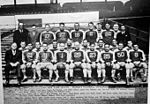Polo Grounds

The Polo Grounds was the name of three stadiums in Upper Manhattan, New York City, used mainly for professional baseball and American football from 1880 through 1963. The original Polo Grounds, opened in 1876 and demolished in 1889, was built for the sport of polo. Bound on the south and north by 110th and 112th streets and on the east and west by Fifth and Sixth (Lenox) avenues, just north of Central Park, it was converted to a baseball stadium when leased by the New York Metropolitans in 1880. The third Polo Grounds, built in 1890, was renovated after a fire in 1911 and became Polo Grounds IV, the one generally indicated when the Polo Grounds is referenced. It was located in Coogan's Hollow and was noted for its distinctive bathtub shape, with very short distances to the left and right field walls and an unusually deep center field. In baseball, the original Polo Grounds was home to the New York Metropolitans from 1880 through 1885, and the New York Giants from 1883 through 1888. The Giants played in the second Polo Grounds for part of the 1889 season and all of the 1890 season, and at the third and fourth Polo Grounds from 1891 through 1957. The Polo Grounds was also the home field of the New York Yankees from 1913 through 1922 and the expansion New York Mets in their first two seasons (1962, 1963). Each of the four versions of the ballpark held at least one World Series. The fourth version also hosted the 1934 and 1942 All-Star Games. In American football, the third Polo Grounds was home to the New York Brickley Giants for one game in 1921 and the New York Giants from 1925 through 1955. The New York Titans/Jets of the American Football League played at the stadium from the league's inaugural season of 1960 through 1963. Other sporting events held at the Polo Grounds included soccer, boxing, and Gaelic football. Its final sporting event was a pro football game between the Jets and Buffalo Bills on December 14, 1963. Shea Stadium opened in 1964 and replaced the Polo Grounds as the home of the Mets and Jets. The Polo Grounds was demolished over a period of four months that year and a public housing complex, known as the Polo Grounds Towers, was built on the site.
Excerpt from the Wikipedia article Polo Grounds (License: CC BY-SA 3.0, Authors, Images).Polo Grounds
Frederick Douglass Boulevard, New York Manhattan
Geographical coordinates (GPS) Address Nearby Places Show on map
Geographical coordinates (GPS)
| Latitude | Longitude |
|---|---|
| N 40.831666666667 ° | E -73.937222222222 ° |
Address
8
Frederick Douglass Boulevard 3005
10039 New York, Manhattan
New York, United States
Open on Google Maps





